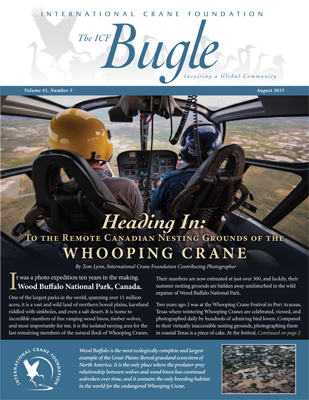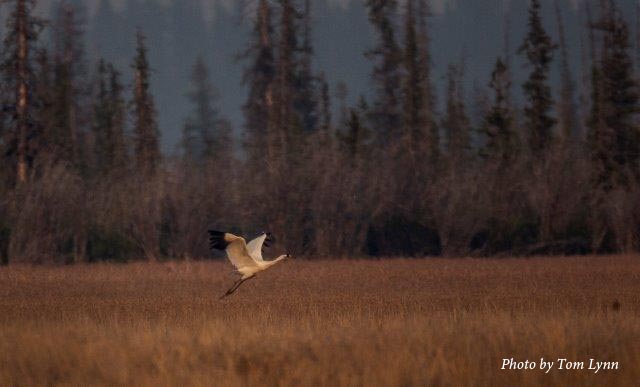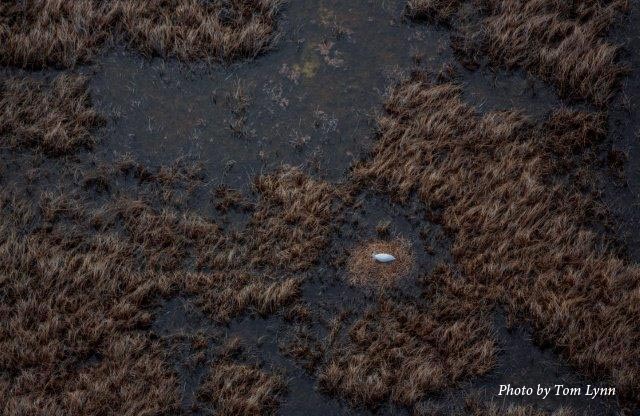
By Tom Lynn, International Crane Foundation Contributing Photographer
Click here to view more photos from Tom’s trip to Wood Buffalo National Park.
It was a photo expedition ten years in the making. Wood Buffalo National Park, Canada. One of the largest parks in the world, spanning over 11 million acres, it is a vast and wild land of northern boreal plains, karstland riddled with sinkholes, and even a salt desert. It is home to incredible numbers of free ranging wood bison, timber wolves, and most importantly for me, it is the isolated nesting area for the last remaining members of the natural flock of Whooping Cranes. Their numbers are now estimated at just over 300, and luckily, their summer nesting grounds are hidden away undisturbed in the wild expanse of Wood Buffalo National Park.
Two years ago, I was at the Whooping Crane Festival in Port Aransas, Texas where wintering Whooping Cranes are celebrated, viewed, and photographed daily by hundreds of admiring bird lovers. Compared to their virtually inaccessible nesting grounds, photographing them in coastal Texas is a piece of cake. At the festival, I heard the Wood Buffalo National Park director (at that time), Rob Kent, speak about the Whooping Cranes in his park. I was captivated by his descriptions and the imagery he presented. I knew I wanted to go there to photograph them, despite the warnings of the outrageous swarms of mosquitoes I might encounter.
 I have been photographing cranes and their landscapes for the International Crane Foundation for many years as a creative outlet to my day job as a photojournalist and sports photographer. With a stipend from the International Crane Foundation and a gracious invitation from the park, I packed my mosquito suit (locals there wear them to mow their lawns!) and camera gear, and was off to the Northwest Territories. Actually, it took a lot of planning to even figure out how to get there – and I am a seasoned traveler! I flew into Edmonton, Alberta and then drove 16 hours north through towns like Little Smokey, Peace River, and Paddle Prairie. When I arrived at the park, I was treated to a meal of elk steaks at the home of Richard Zaidan, the Visitor Experience Manager and my contact at the park.
I have been photographing cranes and their landscapes for the International Crane Foundation for many years as a creative outlet to my day job as a photojournalist and sports photographer. With a stipend from the International Crane Foundation and a gracious invitation from the park, I packed my mosquito suit (locals there wear them to mow their lawns!) and camera gear, and was off to the Northwest Territories. Actually, it took a lot of planning to even figure out how to get there – and I am a seasoned traveler! I flew into Edmonton, Alberta and then drove 16 hours north through towns like Little Smokey, Peace River, and Paddle Prairie. When I arrived at the park, I was treated to a meal of elk steaks at the home of Richard Zaidan, the Visitor Experience Manager and my contact at the park.
During dinner, Richard mentioned a recent unusual sighting of Whooping Cranes at the Salt Plains, outside their usual territories. After dinner, I went there to see for myself. Sure enough, I saw two Whooping Cranes just as the sun was setting (above left, one of the cranes takes flight). My heart skipped a beat – there are people who live in the area their whole lives and never see a Whooping Crane! You can’t imagine the feeling when I saw one fly. Confirmed later by the nesting survey, it was the first pair ever to nest in the Salt Plains. Perhaps this expansion means that it was a good year for reproduction? To reach the nesting pair at a safe distance, yet in range to photograph, required about a mile and a half hike along the Salt River (in bug suit and with bear spray) where I could set up in tall grass. I was not disappointed. They were very active flying, foraging, and chasing Sandhill Cranes from their territory.
 The breeding area for the Whooping Crane is so remote that it wasn’t until the 1950s that it was even discovered. Park biologists conduct helicopter nest surveys twice a year and I was lucky enough to go along on this one. The enormity of the landscape is difficult to comprehend, but from the air, it all comes into focus. While the park biologist took notes and GPS readings of nests, I wrestled with my camera gear in the tight space – switching between a 500mm lens and a short lens to capture the amazing landscape and boreal diatom ponds. Diatom (algae) ponds are a rare wetland associated with nesting Whooping Cranes. As seen from the air, they have a distinctive yellow color caused by the benthic algae community that lives in the water. It is not a stretch to say that as I gazed down from the helicopter at a nesting pair, the ponds were teeming with life. I took hundreds of photos, and I fully understood what a rare opportunity it was. I even saw a family with a chick. For me, this alone made the trip.
The breeding area for the Whooping Crane is so remote that it wasn’t until the 1950s that it was even discovered. Park biologists conduct helicopter nest surveys twice a year and I was lucky enough to go along on this one. The enormity of the landscape is difficult to comprehend, but from the air, it all comes into focus. While the park biologist took notes and GPS readings of nests, I wrestled with my camera gear in the tight space – switching between a 500mm lens and a short lens to capture the amazing landscape and boreal diatom ponds. Diatom (algae) ponds are a rare wetland associated with nesting Whooping Cranes. As seen from the air, they have a distinctive yellow color caused by the benthic algae community that lives in the water. It is not a stretch to say that as I gazed down from the helicopter at a nesting pair, the ponds were teeming with life. I took hundreds of photos, and I fully understood what a rare opportunity it was. I even saw a family with a chick. For me, this alone made the trip.
Later in the week, I flew in a fixed-wing aircraft to the southern end of the park to photograph the Sweet Grass area, where large herds of buffalo graze on seemingly endless grasslands. It felt like I had gone back in time as we flew across this surreal landscape dotted with wild buffalo and ancient birds. It probably looked the same thousands of years ago.
My visit to Wood Buffalo National Park was a wonderful experience, and I am thankful for the opportunity to share these photographs of the park and the elusive nesting grounds of our beloved Whooping Cranes.
